warning RENAULT TWINGO 2009 2.G Engine And Peripherals Manual Online
[x] Cancel search | Manufacturer: RENAULT, Model Year: 2009, Model line: TWINGO, Model: RENAULT TWINGO 2009 2.GPages: 652
Page 348 of 652
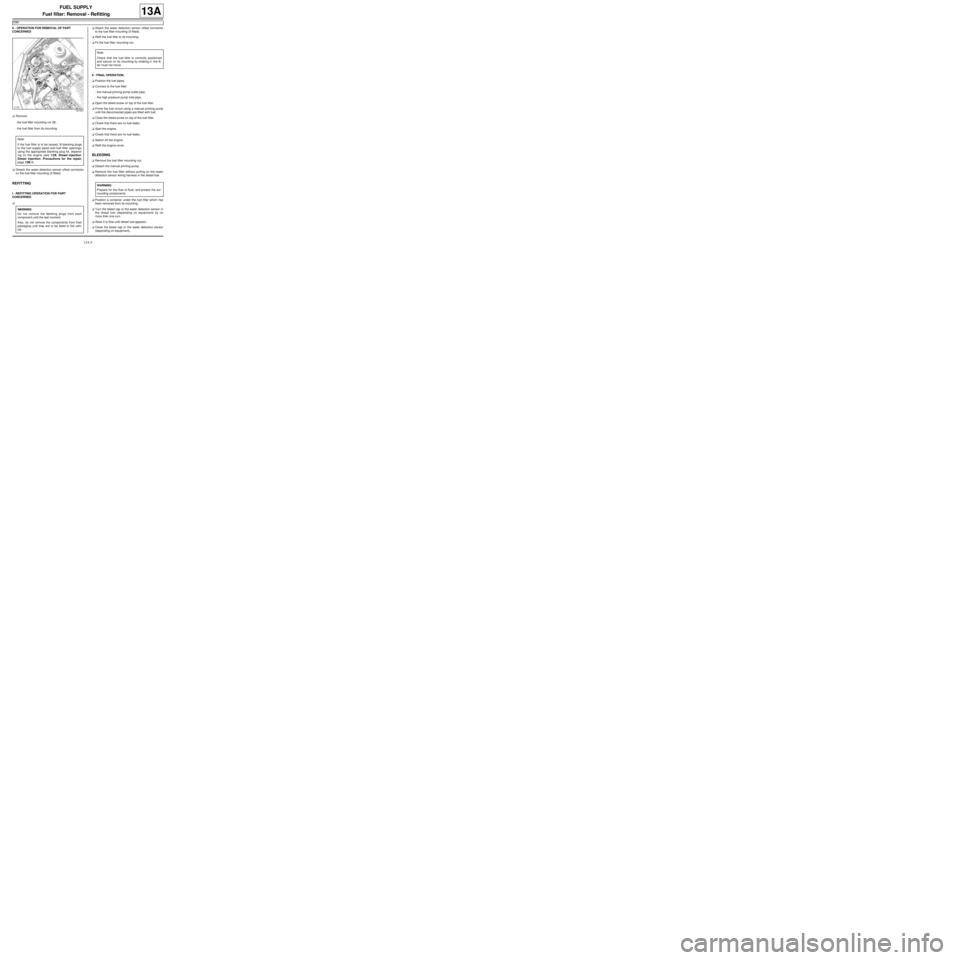
13A-5
FUEL SUPPLY
Fuel filter: Removal - Refitting
K9K
13A
II - OPERATION FOR REMOVAL OF PART
CONCERNED
aRemove:
-the fuel filter mounting nut (3) ,
-the fuel filter from its mounting.
aDetach the water detection sensor offset connector
on the fuel filter mounting (if fitted).
REFITTING
I - REFITTING OPERATION FOR PART
CONCERNED
aaAttach the water detection sensor offset connector
to the fuel filter mounting (if fitted).
aRefit the fuel filter to its mounting.
aFit the fuel filter mounting nut.
II - FINAL OPERATION.
aPosition the fuel pipes.
aConnect to the fuel filter:
-the manual priming pump outlet pipe,
-the high pressure pump inlet pipe.
aOpen the bleed screw on top of the fuel filter.
aPrime the fuel circuit using a manual priming pump
until the disconnected pipes are filled with fuel.
aClose the bleed screw on top of the fuel filter.
aCheck that there are no fuel leaks.
aStart the engine.
aCheck that there are no fuel leaks.
aSwitch off the engine.
aRefit the engine cover.
BLEEDING
aRemove the fuel filter mounting nut.
aDetach the manual priming pump.
aRemove the fuel filter without pulling on the water
detection sensor wiring harness in the diesel fuel.
aPosition a container under the fuel filter which has
been removed from its mounting.
aTurn the bleed cap or the water detection sensor in
the diesel fuel (depending on equipment) by no
more than one turn.
aAllow it to flow until diesel fuel appears.
aClose the bleed cap or the water detection sensor
(depending on equipment).
121441
Note:
If the fuel filter is to be reused, fit blanking plugs
to the fuel supply pipes and fuel filter openings,
using the appropriate blanking plug kit, depend-
ing on the engine (see 13B, Diesel injection,
Diesel injection: Precautions for the repair,
page 13B-1) .
WARNING
Do not remove the blanking plugs from each
component until the last moment.
Also, do not remove the components from their
packaging until they are to be fitted to the vehi-
cle.
Note:
Chec k that the fuel filter is correctly positioned
and secure on its mounting by shaking it: the fil-
ter must not move.
WARNING
Prepare for the flow of fluid, and protect the sur-
rounding components.
Page 352 of 652
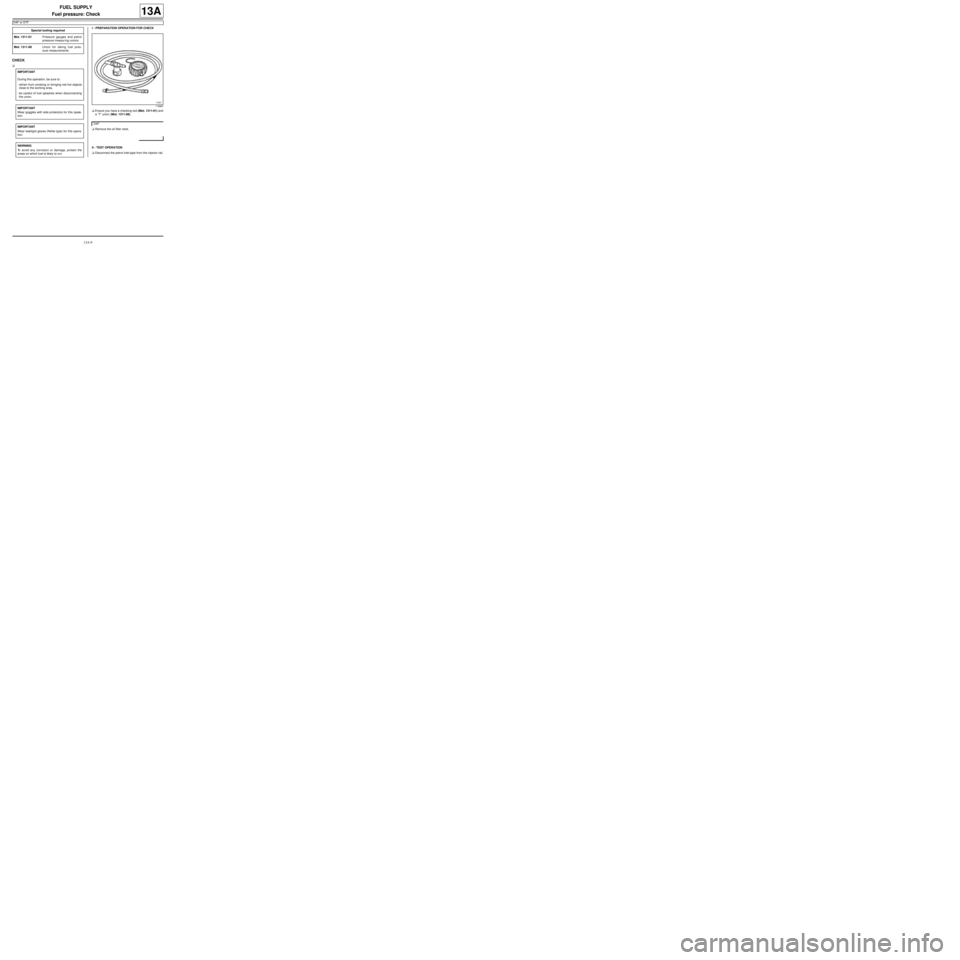
13A-9
FUEL SUPPLY
Fuel pressure: Check
D4F or D7F
13A
CHECK
aI - PREPARATION OPERATION FOR CHECK
aEnsure you have a checking tool (Mot. 1311-01) and
a “T” union (Mot. 1311-08).
aRemove the oil filler neck.
II - TEST OPERATION
aDisconnect the petrol inlet pipe from the injector rail. Special tooling required
Mot. 1311-01Pressure gauges and petrol
pressure measur ing unions.
Mot. 1311-08Union for taking fuel pres-
sure measurements .
IMPORTANT
During this operation, be sure to:
-refrain from smoking or bringing red hot objects
close to the working area,
-be careful of fuel splashes when disconnecting
the union.
IMPORTANT
Wear goggles with side protectors for this opera-
tion.
IMPORTANT
Wear leaktight gloves (Nitrile type) for this opera-
tion.
WARNING
To avoid any corrosion or damage, protect the
areas on which fuel is likely to run.
116887
D4F
Page 355 of 652
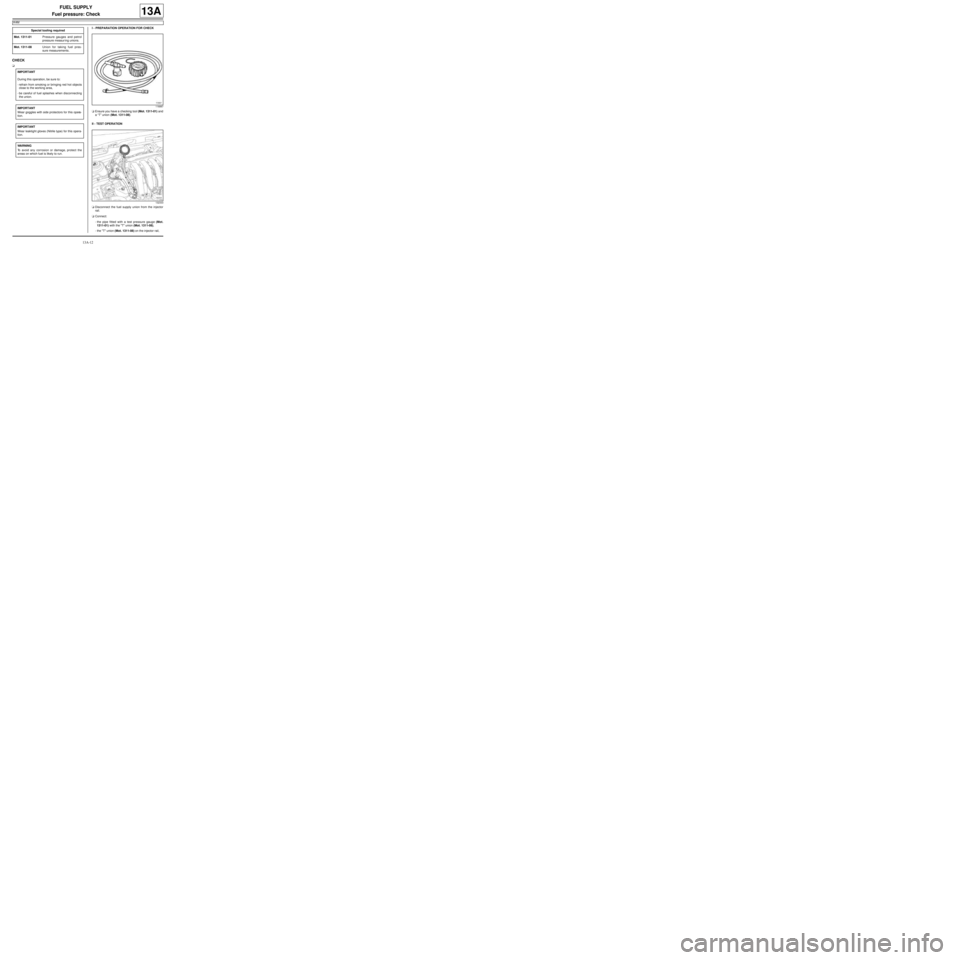
13A-12
FUEL SUPPLY
Fuel pressure: Check
K4M
13A
CHECK
aI - PREPARATION OPERATION FOR CHECK
aEnsure you have a checking tool (Mot. 1311-01) and
a “T” union (Mot. 1311-08).
II - TEST OPERATION
aDisconnect the fuel supply union from the injector
rail.
aConnect:
-the pipe fitted with a test pressure gauge (Mot.
1311-01) with the "T" union (Mot. 1311-08),
-the "T" union (Mot. 1311-08) on the injector rail, Special tooling required
Mot. 1311-01Pressure gauges and petrol
pressure measur ing unions.
Mot. 1311-08Union for taking fuel pres-
sure measurements .
IMPORTANT
During this operation, be sure to:
-refrain from smoking or bringing red hot objects
close to the working area,
-be careful of fuel splashes when disconnecting
the union.
IMPORTANT
Wear goggles with side protectors for this opera-
tion.
IMPORTANT
Wear leaktight gloves (Nitrile type) for this opera-
tion.
WARNING
To avoid any corrosion or damage, protect the
areas on which fuel is likely to run.
116887
132333
Page 357 of 652
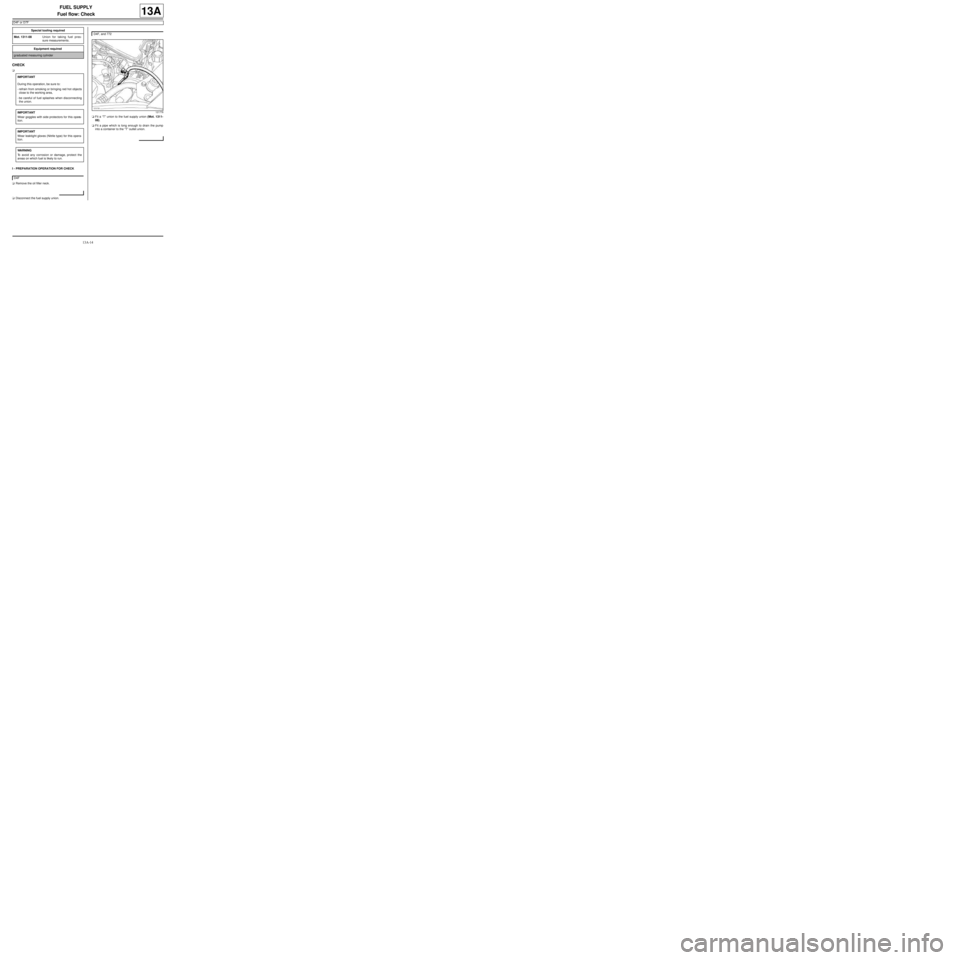
13A-14
FUEL SUPPLY
Fuel flow: Check
D4F or D7F
13A
CHECK
a
I - PREPARATION OPERATION FOR CHECK
aRemove the oil filler neck.
aDisconnect the fuel supply union.aFit a “T” union to the fuel supply union (Mot. 1311-
08).
aFit a pipe which is long enough to drain the pump
into a container to the “T” outlet union. Special tooling required
Mot. 1311-08Union for taking fuel pres-
sure measurements .
Equipment required
graduated measuring cylinder
IMPORTANT
During this operation, be sure to:
-refrain from smoking or bringing red hot objects
close to the working area,
-be careful of fuel splashes when disconnecting
the union.
IMPORTANT
Wear goggles with side protectors for this opera-
tion.
IMPORTANT
Wear leaktight gloves (Nitrile type) for this opera-
tion.
WARNING
To avoid any corrosion or damage, protect the
areas on which fuel is likely to run.
D4F
D4F, and 772
121778
Page 360 of 652
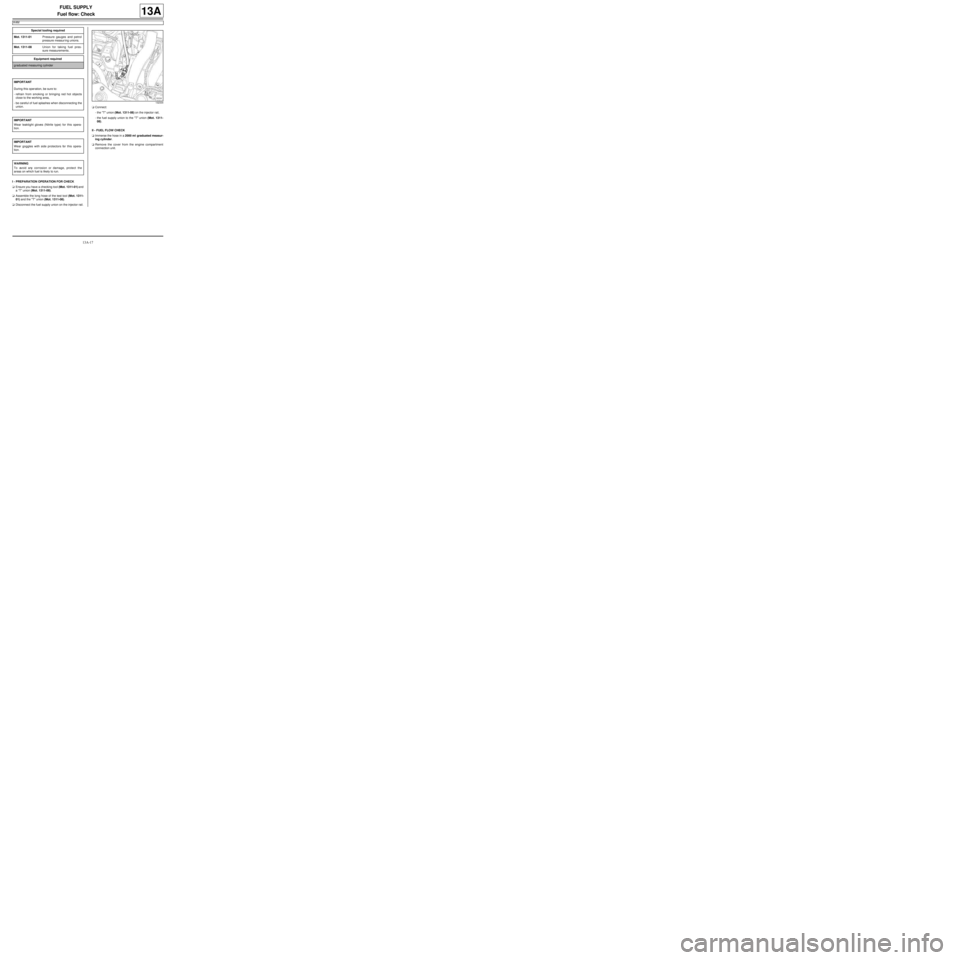
13A-17
FUEL SUPPLY
Fuel flow: Check
K4M
13A
I - PREPARATION OPERATION FOR CHECK
aEnsure you have a checking tool (Mot. 1311-01) and
a “T” union (Mot. 1311-08).
aAssemble the long hose of the test tool (Mot. 1311-
01) and the "T" union (Mot. 1311-08).
aDisconnect the fuel supply union on the injector rail.aConnect:
-the "T" union (Mot. 1311-08) on the injector rail,
-the fuel supply union to the "T" union (Mot. 1311-
08).
II - FUEL FLOW CHECK
aImmerse the hose in a 2000 ml graduated measur-
ing cylinder.
aRemove the cover from the engine compartment
connection unit. Special tooling required
Mot. 1311-01Pressure gauges and petrol
pressure measur ing unions.
Mot. 1311-08Union for taking fuel pres-
sure measurements .
Equipment required
graduated measuring cylinder
IMPORTANT
During this oper ation, be sure to:
-refrain from smoking or bringing red hot objects
close to the working area,
-be careful of fuel splashes when disconnecting the
union.
IMPORTANT
Wear leaktight gloves (Nitrile type) for this opera-
tion.
IMPORTANT
Wear goggles with side protectors for this opera-
tion.
WARNING
To avoid any corrosion or damage, protect the
areas on which fuel is likely to run.
132334
Page 362 of 652
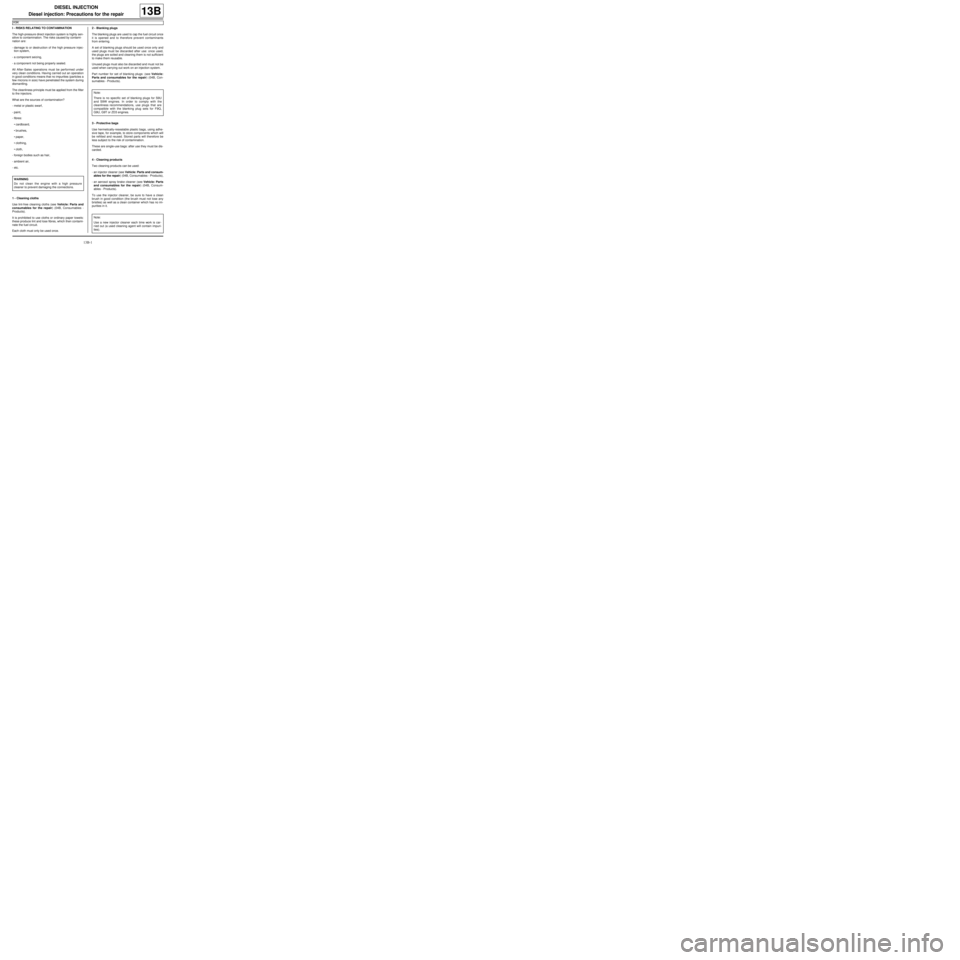
13B-1
DIESEL INJECTION
Diesel injection: Precautions for the repair
K9K
13B
I - RISKS RELATING TO CONTAMINATION
The high-pressure direct injection system is highly sen-
sitive to contamination. The risks caused by contami-
nation are:
-damage to or destruction of the high pressure injec-
tion system,
-a component seizing,
-a component not being properly sealed.
All After-Sales operations must be performed under
very clean conditions. Having carried out an operation
in good conditions means that no impurities (particles a
few microns in size) have penetrated the system during
dismantling.
The cleanliness principle must be applied from the filter
to the injectors.
What are the sources of contamination?
-metal or plastic swarf,
-paint,
-fibres:
•cardboard,
•brushes,
•paper,
•clothing,
•cloth,
-foreign bodies such as hair,
-ambient air,
-etc.
1 - Cleaning cloths
Use lint-free cleaning cloths (see Vehicle: Parts and
consumables for the repair) (04B, Consumables -
Products).
It is prohibited to use cloths or ordinary paper towels:
these produce lint and lose fibres, which then contami-
nate the fuel circuit.
Each cloth must only be used once.2 - Blanking plugs
The blanking plugs are used to cap the fuel circuit once
it is opened and to therefore prevent contaminants
from entering.
A set of blanking plugs should be used once only and
used plugs must be discarded after use: once used,
the plugs are soiled and cleaning them is not sufficient
to make them reusable.
Unused plugs must also be discarded and must not be
used when carrying out work on an injection system.
Part number for set of blanking plugs: (see Vehicle:
Parts and consumables for the repair) (04B, Con-
sumables - Products).
3 - Protective bags
Use hermetically-resealable plastic bags, using adhe-
sive tape, for example, to store components which will
be refitted and reused. Stored parts will therefore be
less subject to the risk of contamination.
These are single-use bags: after use they must be dis-
carded.
4 - Cleaning products
Two cleaning products can be used:
-an injector cleaner (see Vehicle: Parts and consum-
ables for the repair) (04B, Consumables - Products),
-an aerosol spray brake cleaner (see Vehicle: Parts
and consumables for the repair) (04B, Consum-
ables - Products).
To use the injector cleaner, be sure to have a clean
brush in good condition (the brush must not lose any
bristles) as well as a clean container which has no im-
purities in it. WARNING
Do not clean the engine with a high pressure
cleaner to prevent damaging the connections.
Note:
There is no specific set of blanking plugs for S9U
and S9W engines. In order to comply with the
cleanliness recommendations, use plugs that are
compatible with the blanking plug sets for F9Q,
G9U, G9T or ZD3 engines.
Note:
Use a new injector cleaner each time work is car-
ried out (a used cleaning agent will contain impuri-
ties).
Page 364 of 652
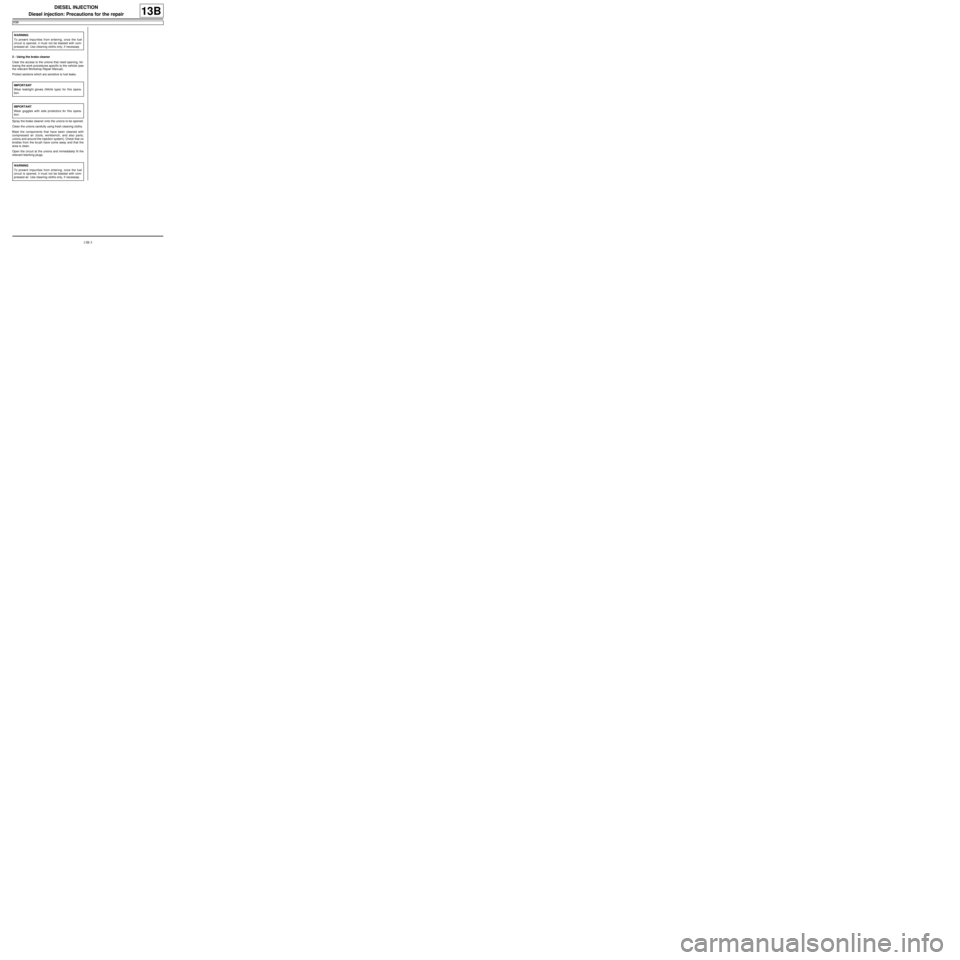
13B-3
DIESEL INJECTION
Diesel injection: Precautions for the repair
K9K
13B
2 - Using the brake cleaner
Clear the access to the unions that need opening, fol-
lowing the work procedures specific to the vehicle (see
the relevant Workshop Repair Manual).
Protect sections which are sensitive to fuel leaks.
Spray the brake cleaner onto the unions to be opened.
Clean the unions carefully using fresh cleaning cloths.
Blast the components that have been cleaned with
compressed air (tools, workbench, and also parts,
unions and around the injection system). Check that no
bristles from the brush have come away and that the
area is clean.
Open the circuit at the unions and immediately fit the
relevant blanking plugs.WARNING
To prevent impurities from entering, once the fuel
circuit is opened, it must not be blasted with com-
pressed air. Use cleaning cloths only, if necessary.
IMPORTANT
Wear leaktight gloves (Nitrile type) for this opera-
tion.
IMPORTANT
Wear goggles with side protectors for this opera-
tion.
WARNING
To prevent impurities from entering, once the fuel
circuit is opened, it must not be blasted with com-
pressed air. Use cleaning cloths only, if necessary.
Page 378 of 652
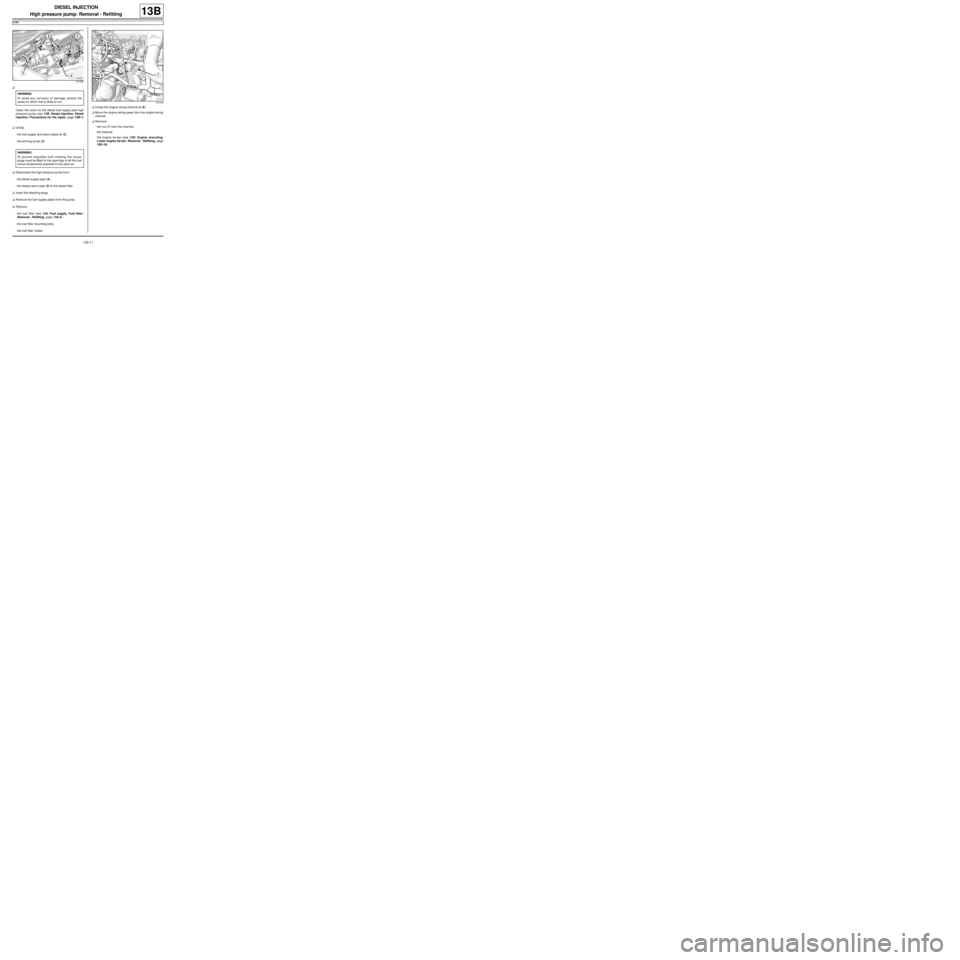
13B-17
DIESEL INJECTION
High pressure pump: Removal - Refitting
K9K
13B
a
Clean the union on the diesel fuel supply pipe high
pressure pump (see 13B, Diesel injection, Diesel
injection: Precautions for the repair, page 13B-1)
.
aUnclip:
-the fuel supply and return pipes at (2) ,
-the priming pump (3) .
aDisconnect the high pressure pump from:
-the diesel supply pipe (4) ,
-the diesel return pipe (5) to the diesel filter.
aInsert the blanking plugs.
aRemove the fuel supply pipes from the pump.
aRemove:
-the fuel filter (see 13A, Fuel supply, Fuel filter:
Removal - Refitting, page 13A-4) ,
-the fuel filter mounting bolts,
-the fuel filter holder,aUnclip the engine wiring channel at (6) .
aMove the engine wiring away from the engine wiring
channel.
aRemove:
-the nut (7) from the channel,
-the channel,
-the engine tie-bar (see 19D, Engine mounting,
Lower engine tie-bar: Removal - Refitting, page
19D-18) .
121423
WARNING
To avoid any corrosion or damage, protect the
areas on which fuel is likely to run.
WARNING
To prevent impurities from entering the circuit,
plugs must be fitted to the openings of all the fuel
circuit components exposed to the open air.
121419
Page 379 of 652
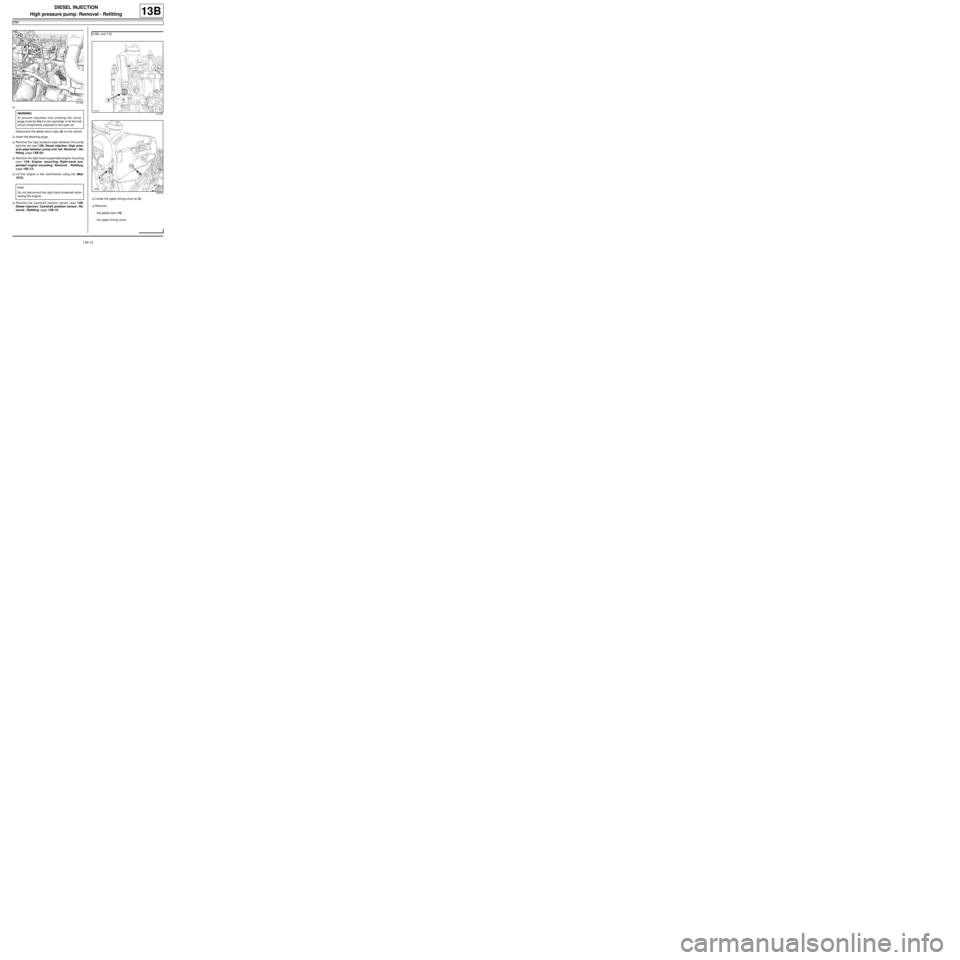
13B-18
DIESEL INJECTION
High pressure pump: Removal - Refitting
K9K
13B
a
Disconnect the diesel return pipe (8) on the venturi.
aInsert the blanking plugs.
aRemove the high pressure pipe between the pump
and the rail (see 13B, Diesel injection, High pres-
sure pipe between pump and rail: Removal - Re-
fitting, page 13B-35)
aRemove the right-hand suspended engine mounting
(see 19D, Engine mounting, Right-hand sus-
pended engine mounting: Removal - Refitting,
page 19D-13) .
aLift the engine a few centimetres using the (Mot.
1672).
aRemove the camshaft position sensor (see 13B,
Diesel injection, Camshaft position sensor: Re-
moval - Refitting, page 13B-14) .aUnclip the upper timing cover at (9) .
aRemove:
-the plastic bolt (10) ,
-the upper timing cover.
121420
WARNING
To prevent impurities from entering the circuit,
plugs must be fitted to the openings of all the fuel
circuit components exposed to the open air.
Note:
Do not disconnect the right-hand driveshaft when
raising the engine.
K9K, and 718
141221
136654
Page 384 of 652
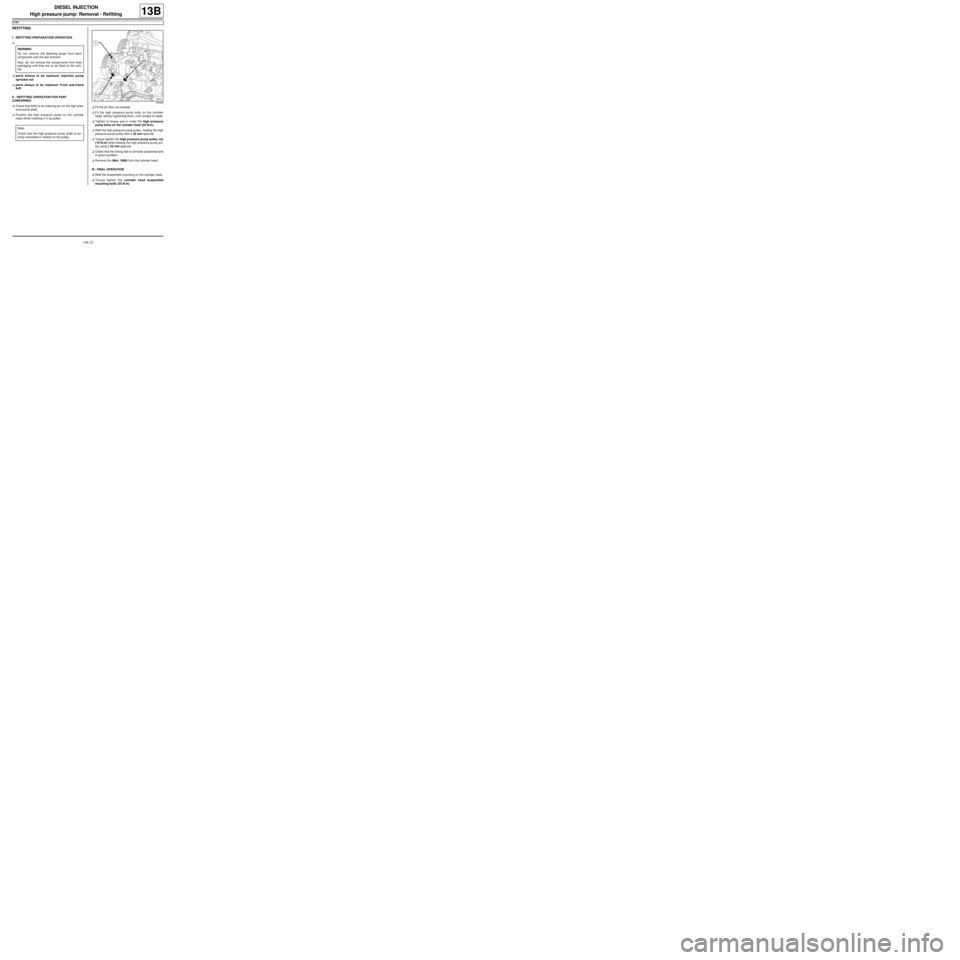
13B-23
DIESEL INJECTION
High pressure pump: Removal - Refitting
K9K
13B
REFITTING
I - REFITTING PREPARATION OPERATION
a
aparts always to be replaced: Injection pump
sprocket nut
aparts always to be replaced: Front sub-frame
bolt
II - REFITTING OPERATION FOR PART
CONCERNED
aCheck that there is an indexing pin on the high pres-
sure pump shaft.
aPosition the high pressure pump on the cylinder
head whilst inserting it in its pulley.aFit the air filter unit bracket.
aFit the high pressure pump bolts on the cylinder
head, without tightening them, until contact is made.
aTighten to torque and in order the high pressure
pump bolts on the cylinder head (23 N.m).
aRefit the high pressure pump pulley, holding the high
pressure pump pulley with a 32 mm spanner.
aTorque tighten the high pressure pump pulley nut
(70 N.m) while holding the high pressure pump pul-
ley using a 32 mm spanner.
aCheck that the timing belt is correctly positioned and
in good condition.
aRemove the (Mot. 1606) from the cylinder head.
III - FINAL OPERATION
aRefit the suspended mounting on the cylinder head.
aTorque tighten the cylinder head suspended
mounting bolts (25 N.m). WARNING
Do not remove the blanking plugs from each
component until the last moment.
Also, do not remove the components from their
packaging until they are to be fitted to the vehi-
cle.
Note:
Check that the high pressure pump shaft is cor-
rectly orientated in relation to the pulley.
102085